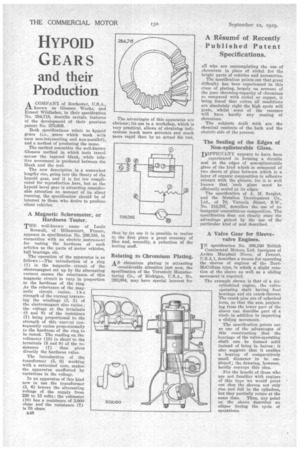HYPOID GEARS
Page 74

If you've noticed an error in this article please click here to report it so we can fix it.
and their
Production
A Resume of Recently Published Patent Specifications.
ACOMPANY of Rochester, U.S.A., known as Gleason Works, and Ernest Wildhaber, in their specification No. 284,718, describe certain features of the development of their previous patent No. 270,669.
Both specifications relate to hypoid gears (i.e., gears which mesh with axes non-intersecting and non-parallel), and a method of producing the same.
The method resembles the well-known Gleason method in which tools travel across the tapered blank, while relative movement is produced between the blank and the tool.
The new description is a somewhat lengthy one, going into the theory of the hypoid gear, and it is far too complicated for reproduction -here, hut as the hypoid bevel gear is attracting considerable attention on account of its silent running, the specification should be of interest to those who desire to produce silent vehicles.
A Magnetic Sclerometer, or Hardness Tester.
THE well-known name of Louis
Renault, of Billaneourt, France, appears in specification No. 299,388, in connection with an electric instrument for testing the hardness of such articles as the parts of motor vehicles, ball bearings, etc.
The operation of the apparatus is as follows :—The introduction of a ring (1) in the magnetic circuit of the electromagnet set up by the alternating current causes the reluctance, of this magnetic circuit to vary in proportion to the hardness of the ring. As the reluctance of the magnetic circuit varies, t h e strength of the current traversing the windings (3, 3) of the electromagnet also varies ; the voltage at the terminals (8 and 9) of the resistance (7) being proportional to the strength of this curr2nt consequently varies proportionally to the hardness of the ring to be tested.. The reading on the voltmeter (10) in shunt to the terminals (8 and 9) of the resistance (7) thus gives directly the hardness value.
The introduction of the transformer (5, 6) working with a saturated core, makes the apparatus unaffected by variations in the voltage.
In an apparatus of ibis kind now in use the transformer (5, 6) lowers the alternating voltage of the supply from 220 to 15 volts ; the voltmeter (10) has a resistance of 3,000 ohms and the resistance (7) is 70 ohms.
1148 all who are contemplating the use of chromium in place of nickel for the bright parts of vehicles and accessories.
The specification points out that great difficulty has been experienced in this class of plating, largely on account of the poor throwing-capacity of chromium as compared with nickel or copper, it being found that unless all conditions are absolutely right the high spots will ptate, whilst some of the recesses will have hardly any coating of chromium.
The subjects dealt with are the chemical contents of the bath and the electric side of the process.
The Sealing of the Edges of Non-splinterable Glass.
DIFFICULTY appears to have been experienced in forming a durable seal at the edges of non-splinterable glass of the kind which is composed of two sheets of glass between which is a layer of organic composition in adhesive contact with the glasses, for it is well known that such glass must be efficiently sealed at its edges.
The specification of A. M. Sargint, and the Metallon Development Co., Ltd., of 70, Victoria Street, S.W., No. 316,797, describes the use of an inorganic cementitious composition. The specification does not clearly state the advantage gained by the use of the Particular kind of seal described.
A Valve Gear for Sleevevalve Engines.
IN specification No. 309,160 British
Continental Motors, Ltd. (assignee of Archie Macphail Niven, of Detroit, U.S.A.), describes a means for operating the sleeves of engines of the BurtMcCullum type, in which a slight rotation of the sleeve as well as a sliding movement is required.
The example shown is that of a sixcylinde.red engine, the valveoperating shaft having four bearings and six crank-throws. The crank pins are of spherical form, so that the arm projecting from the lower part of the sleeve can describe part of a circle in addition to imparting a sliding movement.
The specification points out as one of the advantages of this construction that the bearings of the valve-operating shaft can be formed solid instead of being in halves; it also suggests that it enables a bearing of comparatively small diameter to be employed; the drawing, however, hardly conveys this idea.
For the benefit of those who are not familiar with engines of this type we would point ont that the sleeves not only rise and fall in the cylinders, but they partially rotate at the same time. Thus, any point on the sleeve describes an ellipse during the cycle of operations.




















































































































